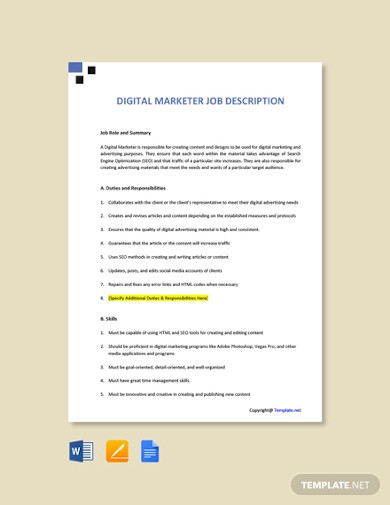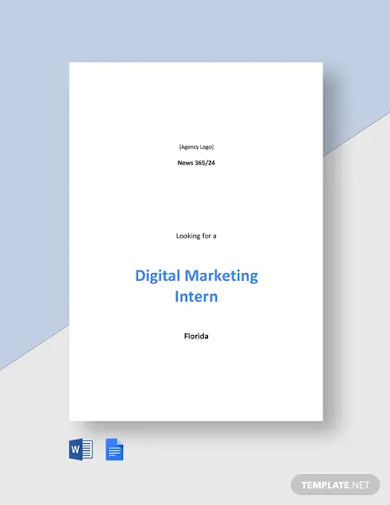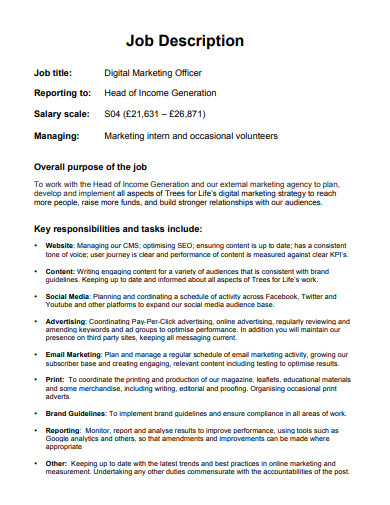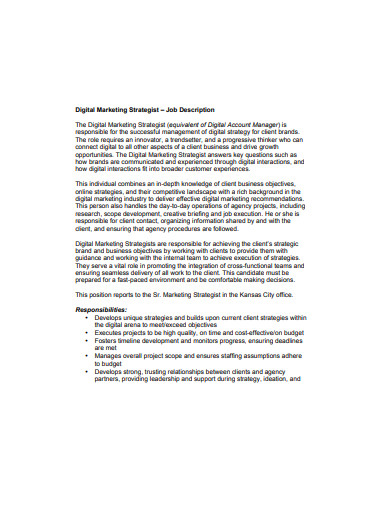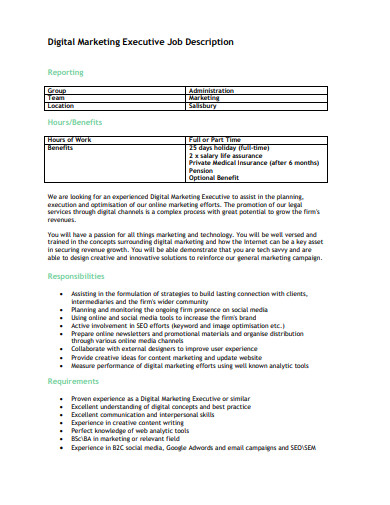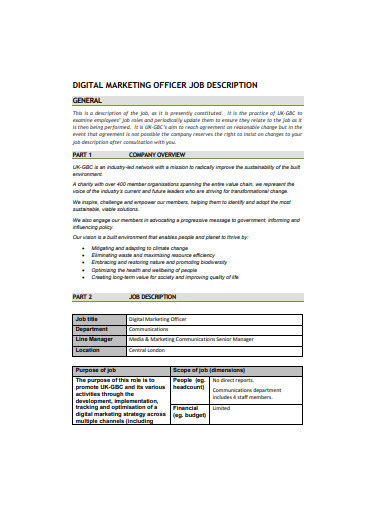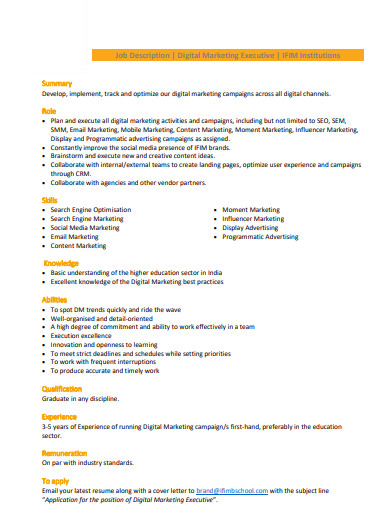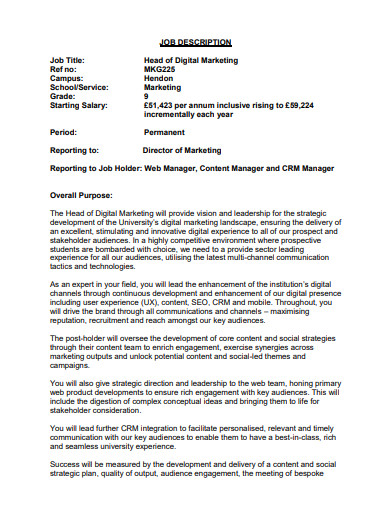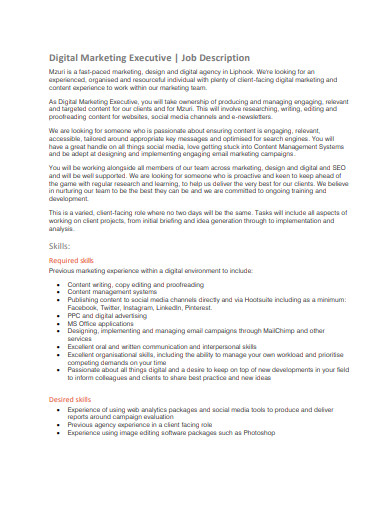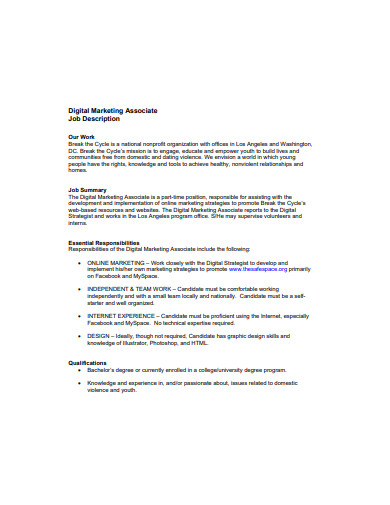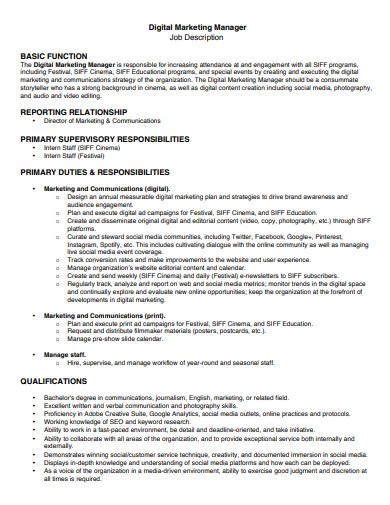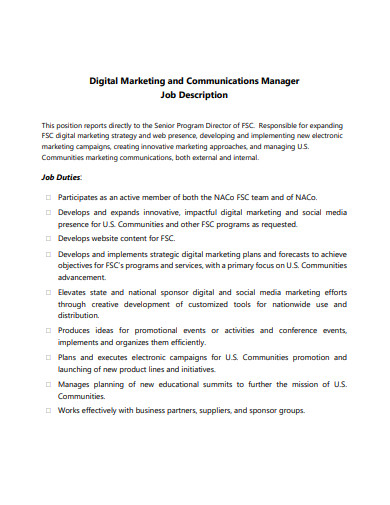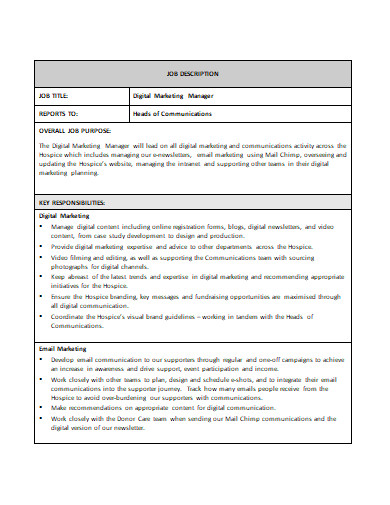20+ Digital Marketing Job Description Examples to Download
The marketing department of a company holds many marketing job positions, such as marketing coordinator, marketing officer, and marketing analyst. These positions must be manned by professionals whose key skills are relevant to marketing, mostly digital, like social media advertising and search engine optimization (SEO). We know how knowledgeable you are of what a digital marketing staff can do for your company. The same goes for your competitors. So, get your company a head start in the race of acquiring such talents through a digital marketing job description. You can learn more about the document as you go further in this article. To start off, check out our 12+ Digital Marketing Job Description Examples in PDF, Microsoft Word, Apple Pages, and Google Docs file formats.
12+ Digital Marketing Job Description Examples in PDF | MS Word | Pages | Google Docs
1. Free Digital Marketing Job Description Template
2. Junior Digital Marketing Job Description Template
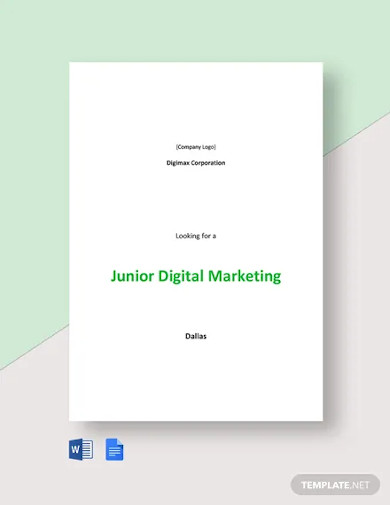
3. Digital Marketing Coordinator Job Description Template
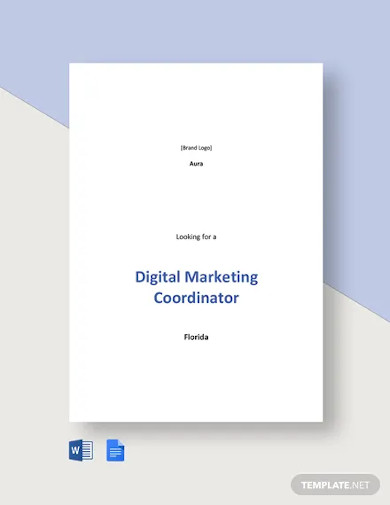
5. Digital Marketing Director Job Description Template
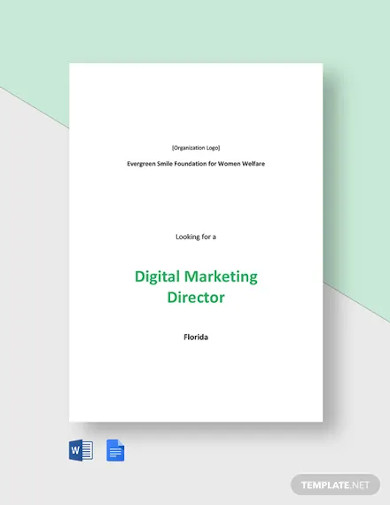
6. Digital Marketing Administrator Job Description Template
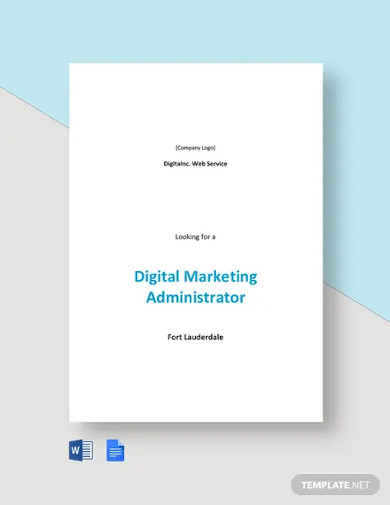
11. Digital Marketing Strategist Job Description
12. Digital Marketing Executive Job Description
13. Digital Marketing Officer Job Description Example
14. Digital Marketing Executive Job Description Format
15. Digital Marketing Manager Job Description
16. Digital Marketing Job Description Example
17. Digital Marketing Executive Job Description Sample
18. Digital Marketing Associate Job Description
19. Sample Digital Marketing Manager Job Description
20. Digital Marketing and Communications Manager Job Description
21. Digital Marketing Manager Job Description in DOC
What Is a Digital Marketing Job Description?
A digital marketing job description is a document that provides job applicants and in-house employees with an overview of a certain digital marketing job position. However, WikiJob pointed out that it is not only the job candidates and existing employees who can benefit from the document but also any company’s recruitment team, as well as its corresponding organization as a whole. On the contrary, the digital marketing job description also has its disadvantages. MBASkool stated that such an indenture needs to be updated every time an organization creates adjustments in any aspect of the operation. The MBA student management knowledge portal also included that it does not cover emotional requirements or another minor basis that may be relevant to any job opening. Lastly, it was mentioned that the lack of information might cause major confusion on all those who benefit from it.
Employers vs Job Aspirants on Job Descriptions
Employers and job aspirants have different views on job descriptions with usage as their context. For employers, the documents serve as a guide for them to assess their employees’ performances, and to assign the appropriate personnel to do a specific business-related task. Not only that, these paperwork help employers also set criteria in their respective search for prospective employees while making the current employees well-informed about their scope of work. In the case of job aspirants, job descriptions function as good references for them to tailor their job application documents, such as resumes or curriculum vitae. In addition, such documents act as handbooks in ensuring that the duties, responsibilities, compensations, benefits align with the job seekers’ knowledge, skills, experiences, and preferences.
How To Write a Thorough Digital Marketing Job Description
A job description is meant to encourage an employee to take a step forward on his or her planned career path, just as how it entices a job hunter to take his or her chances on a particular company and position. With that in mind, there is a need for you to write the document’s details in the most interesting way while maintaining focus in making the specifics clear and thorough. There is no need for you to get pressured because we have prepared our outline of steps below to walk you through in creating your digital marketing job description brief and comprehensive yet compelling.
Step 1: Set the Specific Job Title
When writing your digital marketing job description, you have to start by setting a specific job title. Digital marketing has many areas. And, related job titles that are broadly set have to include all of their complexities, making it ineffective and inefficient for you and the readers of your document.
Step 2: Summarize Job Role
Never forget to give a brief summary of your specific digital marketing job opening. In doing so, make sure to mention what you expect in the position, along with an overview of your corporate organization. Disclosing your workspace environment would surely grab job seekers’ curiosities.
Step 3: State Duties and Responsibilities
State the complete details of your job opening’s set of tasks and obligations. In setting them up, you have to put into account the standard procedures, policies, and regulations. You have to bear in mind that incomplete and inaccurate information on this part of your document will make it a subject for legal complications between employees and employers.
Step 4: Enumerate Qualifications and Requirements
As mentioned above, job descriptions are good references for job seekers. One of the many reasons why is that it provides a complete list of your requirements and qualifications. By enumerating the qualifications, job seekers will know if their experiences, skill sets, and knowledge is fit for the job. On another aspect, the list of requirements allows job seekers to prepare ahead of time the necessary documents that support their credentials.
Step 5: Promote Job Benefits
Truth be told, one major point of employment is to earn financial means. So, making use of this fact would greatly benefit your company as an employer, that is why including the benefits that come with the job opening is highly recommended.
FAQs
What are the basic components of a job description?
Job Title – names that describe employees’ positions within their organizations
Job Role – the function of a particular employee in an office
Duties – set of tasks entailed by employment
Responsibilities – the employees’ obligations indicated by their employers
Qualifications – job-related qualities, experiences, knowledge, and skills required by employers to job applicants
Requirements – the needed documents that can support the job applicants’ claimed credentials
Benefits – social security payments, compensations, and incentives that are given by employers to employees after successfully fulfilling their duties
How does a job description help in someone’s career path?
Job descriptions play vital roles in achieving employees’ career paths. Through the pieces of information that they entail, employees will not have a problem in setting up their career goals. For example, a manager job description has just been posted. Interested regular employees will then rush into the posting to see what training programs they should take to develop the skill sets that the managerial position required.
How much is the typical earnings of digital marketers in a year?
Based on Indeed’s April 2020 statistics, the average annual salary of a digital marketer is USD 61,757. This was estimated from their received job advertisements for the past three years. Additionally, the numerical data also showed that the job position’s minimum wage is USD 14,000, while the maximum stands at USD 151,000.
Job descriptions are important tools that are beneficial for three groups – employer, recruitment teams, and job seekers. In addition to that, such documents are advantageous to each group in different ways. Despite the different views on how the paperwork is used, its function as a guide to any operation or activities is common.



